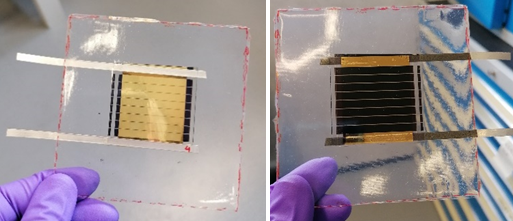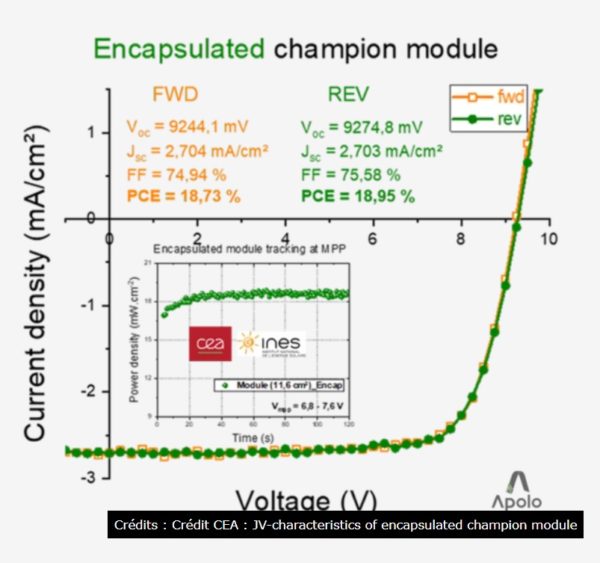From pv magazine France
Researchers at France's National Solar Energy Institute (INES) – a division of the French Alternative Energies and Atomic Energy Commission (CEA) – have developed new flexible perovskite solar modules.
They have a surface area of 11.6 square centimeters, with a maximum power conversion efficiency of 18.95% and a stabilized efficiency of more than 18.5%. INES said the performance is a world record for a flexible perovskite device larger than 10 square centimeters.

Currently, the power conversion efficiencies of solar devices based on perovskites indeed exceed 25% for single junctions and 29% in tandem structures with silicon. However, these results are obtained on small surfaces, of the order of 1 square centimeters.
To obtain this yield on larger surfaces, INES developed the flexible perovskite solar modules at low temperature on low-cost substrates made of polyethylene terephthalate (PET). They used a very simple structure featuring five layers, including the electrodes.
The performance is obtained after encapsulation and the stability of the devices has been tested under damp heat conditions at 85 C, according to the standards used for silicon-based technologies. A stability of several hundred hours has been obtained – between 400 and 800 hours, depending on encapsulation – based on a standard objective of 1,000 hours.
To achieve this result, the CEA optimized the stacking of the layers of the cell to implement a three-step laser process for the production of the module. It also developed a flexible encapsulation process that is fully compatible with high gas barrier materials, with no initial loss.

The CEA's devices will be integrated into a demonstrator for building-integrated photovoltaic (BIPV) applications by Flexbrick (Es), a member of the European consortium. The modules will be interconnected to obtain high voltages and will be tested according to building standards. In addition, stability tests in real conditions are currently being carried out.
The Fraunhofer Institute for Solar Energy Systems (Fraunhofer ISE) in Germany, a project partner, is testing the panels for indoor applications. The tests have already shown power conversion efficiencies of up to 24.5% at very low light (500 lux).
For some applications, the use of flexible substrates could be of interest for single-junction perovskite technology, because it could open the way to high-speed and low-temperature printing processes. It therefore becomes possible to use low-cost substrates unlike flexible inorganic technologies, such as CIGS, which require higher temperature processes and more expensive substrates.
Many teams around the world are trying to meet the challenges of making larger devices with sufficient stability for real-world applications. This is one of the tasks set by the partners of the European APOLO project.
This content is protected by copyright and may not be reused. If you want to cooperate with us and would like to reuse some of our content, please contact: editors@pv-magazine.com.




3 comments
By submitting this form you agree to pv magazine using your data for the purposes of publishing your comment.
Your personal data will only be disclosed or otherwise transmitted to third parties for the purposes of spam filtering or if this is necessary for technical maintenance of the website. Any other transfer to third parties will not take place unless this is justified on the basis of applicable data protection regulations or if pv magazine is legally obliged to do so.
You may revoke this consent at any time with effect for the future, in which case your personal data will be deleted immediately. Otherwise, your data will be deleted if pv magazine has processed your request or the purpose of data storage is fulfilled.
Further information on data privacy can be found in our Data Protection Policy.